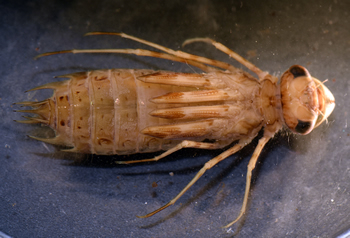 Aquatic Insects of Michigan
Aquatic Insects of Michigan
by Ethan Bright, Museum of Zoology Insect Division and School of Natural Resources and Environment
University of Michigan
- Home
- Species Lists
- Coleoptera
- Diptera
- Ephemeroptera
- Acanthametropodidae
- Ameletidae
- Ametropodidae
- Arthropleidae
- Baetidae
- Baetiscidae
- Behningiidae
- Caenidae
- Ephemerellidae
- Ephemeridae
- Heptageniidae
- Isonychiidae
- Leptohyphidae
- Leptophlebiidae
- Metretopodidae
- Neoephemeridae
- Oligoneuriidae
- Palingeniidae
- Polymitarcyidae
- Potamanthidae
- Pseudironidae
- Siphlonuridae
- Heteroptera
- Hymenoptera
- Lepidoptera
- Megaloptera
- Neuroptera (Sisyridae)
- Odonata
- Orthoptera
- Plecoptera
- Trichoptera
- Other Orders
- Keys/Identification
- Aquatic Insects of Michigan
Pantala (Libellulidae) (Gliders) of Michigan - Identification
There are two species of Pantala in North America, both of which occur within our range. Adults are large, strong fliers with very wide distribution. P. flavescens is cosmopolitan and distributed around the world, and both our species are migratory, with adults often suddenly appearing in large numbers. Adults are yellow or yellow-brown with a pale face and an expanded hind wing that assists in flight (gliding). Nymphs are similar to Tramea, clean in appearance and pale, greenish with light brown markings. Like that of other highly migratory dragonflies, nymphs are active, fast-growing predators that adapt well to temporary lentic habitats, including those created by man. Development and descriptions of each instar for P. flavescens was thoroughly treated by Lamb (1925, 1929) and Byers (1941) and summarized by Huggins and Brigham (1982). Prey varies from small invertebrates and probably zooplankton in earlier instars, to macroinvertebrates and even small fish in later instars, depending on habitat (Byers 1941, Lamb 1925, Warren 1915). Time period for nymphal development probably varies considerably, depending on temperature and food availability, among other factors, and has been reported from 145 to as little as 36 days (Lamb 1925, Warren 1915, Bick 1951). It is not known whether nymphs overwinter in Michigan. (Taxonomic References: Needham et al. 2010, Paulson 2011, Tennessen 2019, Walker and Corbet 1975). (Photo: Pantala flavescens, copyright 2017 Ethan Bright).
Adults
1a a. Hindwings each with a large brown spot near the anal angle Pantala hymenaea (Say) b. Abdomen mostly brown 1b a. Hindwings without a large brown spot near the anal angle
Pantala flavescens (Fabricius)b. Abdomen mostly yellowish or buffy
Mature Nymphs
1a a. Ratio of Ab9 posterolateral spine length : Ab9 midventral length 1.50-1.75
Pantala flavescens (Fabricius)b. Ratio of Ab8 posterolateral spine length : basal width of Ab9 posterolateral spine 1.90-2.60 c. Usually 13-14 palpal setae (rarely 15), total number of setae on two palpi 25-30 1b a. Ratio of Ab9 posterolateral spine length : Ab9 midventral length 1.09-1.32 Pantala hymenaea (Say) b. Ratio of Ab8 posterolateral spine length : basal width of Ab9 posterolateral spine 1.20-1.95 c. Usually 16 or more palpal setae (rarely 15), total number of setae on two palpi 30-36
References
Bick, G. H. 1951. Notes on Oklahoma dragonflies. Journal of the Tennessee Academy of Science 26:178-180.
Byers CF. 1941. Notes on the emergence and life history of the dragonfly Pantala flavescens. Proceedings of the Florida Academy of Science 5:14-25.
Huggins DG, Brigham WU. 1982. Odonata, pp. 4.1-4.100, in Aquatic Insects and Oligochaetes of North and South Carolina. Brigham, A. R., W. U. Brigham and A. Gnilka (eds.). Midwest Aquatic Enterprises: Mahomet, Illinois.
Lamb L. 1925. A tabular account of the differences between the earlier instars of Pantala flavescens (Odonata: Libellulidae). Transactions of the American Entomological Society 50:289-312.
Lamb L. 1929. The later larval stages of Pantala (Odonata: Libellulidae). Transactions of the American Entomological Society 54:331-334.
Needham JG, Westfall MJ, May ML. 2010. Dragonflies of North America, Third Edition. Scientific Publishers, Gainesville, Florida, USA. xiv + 657 p.
Paulson D. 2011. Dragonflies and damselflies of the East. Princeton Field Guides. Princeton University Press, Pinceton, New Jersey, USA. 538 p.
Tennessen KJ. 2019. Dragonfly nymphs of North America: An Identification Guide. Springer International Publishing, Cham, Switzerland: xiv + 620 p.
Walker EM, Corbet JS. 1975. The Odonata of Canada and Alaska, Vol. 3. University of Toronto Press: Toronto, Ontario. xvi + 308.
Warren, A. 1915. A study of the food habits of the Hawaiian dragonflies or Pinau with reference to their economic relation to other insects. College of Hawaii Publications, Bulletin 3. 45 pp.
Page created: July 17, 1998 - Last updated: April 22, 2020